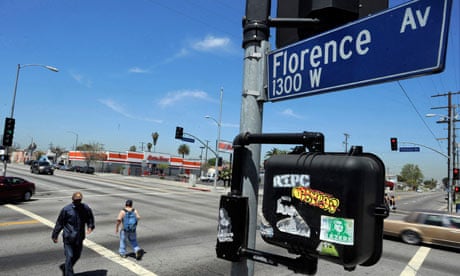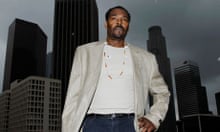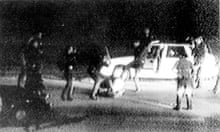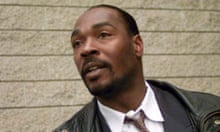It was the intersection of everything that seemed wrong with Los Angeles: a drab urban junction turned into a crucible of rage, despair and anarchy.
Crowds from Normandie and Florence avenues converged around its traffic lights 20 years ago this week and launched what became a spree of riots which devastated Los Angeles and shook the United States.
"We responded to a call about a liquor store robbery but when we got there realised it wasn't just a robbery," recalled Rick Banks, 52, a police lieutenant. "You could tell from the atmosphere. People yelling at us from cars, people gathering, throwing things, shouting profanities. You could see things were beginning to develop."
It was April 29 1992. Hours earlier, a jury had acquitted three white and one Hispanic police officer of assaulting Rodney King, a black motorist whose savage roadside beating – Tasered and repeatedly kicked and bludgeoned – had been captured on film.
The mainly black community of South Central LA responded with fury to the acquittals. "It was boiling point, the perfect storm," said Banks, an African American. "The crowd merged onto the streets and started stopping and harming anyone who didn't look like them."
After evacuating an elderly white couple, Banks, like most of LA's police officers, vanished from the streets, a blunder which haunts the department to this day. A short while later, a TV news helicopter broadcast live footage of a mob beating Reginald Denny, a white trucker, almost to death.
When order was finally restored six days later, the mayhem had consumed 53 lives, a billion dollars worth of property and the reputation of a city which once considered itself a beacon of American optimism. The King and Denny beatings bookended an image of brutality and racial strife.
This week, two decades later, cars whizz past the intersection, indifferent. Normandie and Florence are peaceful. Apart from the gasoline station, liquor store and mobile phone shop, there is no reason to stop.
A walk around the neighbourhood, however, offers a snapshot of how much LA has changed since the flames and the looting – and how much has remained the same. It is a debate which has stirred passions in the run-up to the anniversary.
Gangs are less visible and shootings and stabbings have ebbed, part of a city-wide tumble in homicides from 1,092 per year to 297. Racial tension has also receded, at least on the surface.
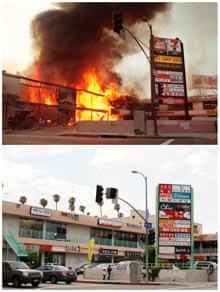
"No problems between us, all good," beamed James Oh, 62, the liquor store's Korean-born owner. "I've never had a robbery here." Two decades ago tension between Korean store owners, who felt menaced by thieves, and African Americans, enraged at the killing of a black girl by a store clerk, helped ignite the mayhem. Korean-owned businesses were among the worst hit.
Oh, cheerful and energetic, said that was all ancient history, and that he felt welcome. The bullet-proof glass and armed guard, he said, were inherited from the previous owner. "I do good business here."
The biggest change in the neighbourhood, comprising rows of one-storey houses with small gardens, is the arrival of Latinos, who now make up 48% of Los Angeles's population. Statues of Virgin Marys and Catholic saints revered in Mexico and central America dot window sills and gardens. The black population has decreased from 11% to 8%.
The shooting death in Florida of Trayvor Martin, a black teenager, by George Zimmerman, a Hispanic, has prompted protests from many of America's black communities, but there is little sign of riots brewing in LA.
"I'm not a soothsayer but in terms of probability I don't think that will happen," said Earl Ofari Hutchinson, a prominent African American author and commentator. "I don't see the same kind of ingredients. Times have changed."
One positive development, everyone agrees, is the LAPD's transformation. Two decades ago it was a fortress dominated by white males, many war veterans, with a thuggish reputation. "We were seen as some type of invading army," said Gus Villanueva, a veteran detective. "But the reason was (the level of) violence on the streets. We were running from one disaster to another."
Today the department has a shiny new downtown headquarters whose surrounding garden is used as a dog park. Almost half its 9,819 officers are Hispanic, and there are many more Asians and female officers than before. It has civilian oversight, fewer complaints and runs multiple community outreach programmes, all part of laborious, incremental changes.
"People learned from the riots. Back then just being a black officer was almost like a curse," said Banks, the lieutenant, who grew up in Normandie and Florence. "When I put on the uniform people accused me of selling out." The community, like the police, had learned lessons. "People were shocked. You destroy your community, it can stay destroyed."
Banks, who retired this week, said the violence was not an insurrection. "It wasn't that the African-American community came out and rioted. No, it wasn't like that. They largely stayed home. It was gangs that whipped things up."
However, Banks said he was disappointed by how things have evolved. "As a city we've made a little progress – but not much." Poverty and unemployment in South Central LA, he said, were just as bad as before.
In fact, a black middle-class has grown fast, creating a visible network of black architects, doctors and managers. Earvin 'Magic' Johnson, the former NBA star, has invested some of his fortune in setting up businesses in deprived areas. He is to set up a TV channel, Aspire, showing a positive image of African Americans.
But the grim, awkward fact of enduring poverty and alienation in South Central LA has overshadowed anniversary debates. Walk a few blocks from the intersection of Florentine and Normandie and you see abandoned lots of weeds and rubble, apparently untouched since 1992.
"No jobs, no jobs," said Kenneth, 50, a resident who withheld his surname, sipping a beer while awaiting the 206 bus. "All you can do here is hustle." Racial grievance remains common. "They're giving Hispanics and other races jobs, but not blacks," said Denis Hamilton, 57, jabbing a cane. "People were upset back then, and they're upset now."
Joe Freeman, 86, a Baptist pastor whose church was used as a police command centre during the riots, said absentee fathers fractured families, tipping boys into gangs' clutches. "It's a cycle," he said. "Goes on and on."
